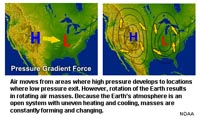8.5: Atmospheric Convection and Air Pressure Gradients/Systems
- Page ID
- 10266
Atmospheric Convection
Convection is the circulation of fluid due to density differences. Atmospheric convection works like a pot of boiling soup, warm fluid rising (in middle) and cool fluid falling (on sides). A rising storm thunderhead is an example of atmospheric convection. Warm moist air rises, expands, releases energy as clouds form. After releasing its heat and moisture, the cooled air sinks, displacing warm air below (Figure 8.13).
Air Pressure Gradients and Air Pressure Systems
• Surface winds blow from high to low pressure - this is called a pressure gradient—displayed as lines of equal barometric pressure on a weather map (Figure 8.14). An air mass is a body of air with a relative horizontally uniform temperature, humidity, and pressure:
• High pressure systems have dry conditions with sinking air masses.
• Low pressure systems have wetter conditions with rising air masses.

Figure 8.14. Air pressure gradients and air pressure systems.



